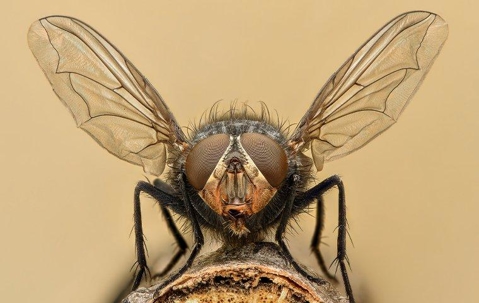Shhhhh, listen. Where’s that buzzing coming from? If it’s your appliances or outside noises, everything is fine, but if it's a housefly, you’ve got a real pest on your hands.
House flies are some of the most common pests out there. By themselves, these insects are harmless, but they’re usually the carriers of pathogens and bacterias that threaten the health of your household. Let’s get into how to identify these pests and prevent them from wreaking havoc on your Bettendorf home.
How To Identify House Flies
House flies are some of the easiest flies to identify, thanks in part to their comparatively large bodies. The average housefly grows between ⅛ and ¼ of an inch in length, with females slightly larger than males. House flies range from dull gray to black, with four black vertical lines on their bodies and a gold or silver stripe on their faces. With six legs, large red eyes, and a set of long, translucent wings, these flies are easy to identify from a mile away.
At some point, a housefly has probably landed on your arm or settled on your food. These vermin are common everywhere, from dumpsters to restaurants to houses, in cities, suburbs, and the countryside. In fact, house flies are so common that many Iowa residents don’t think twice when they see one buzzing around the house. Here’s why a housefly should worry you.
Problems House Flies Cause
House flies are scavengers, which means they’ll eat virtually anything, but are most often drawn to waste. You’ll often see them crowding around dumpsters, piles of excrement, and carcasses, though of course, they’ll eat anything including both human and pet food. Since house flies crowd around unsanitary areas, you can imagine all the different pathogens they pick up, right?
If a housefly makes its way to your house, it probably didn’t come from a hospital or a janitor’s closet, it came from a dumpster or some other unsanitary place. This is why house flies pose a real concern to Bettendorf residents: since they crowd around unsanitary places, they vector loads of diseases. Common pathogens associated with house flies include typhoid, diphtheria, cholera, conjunctivitis, tuberculosis, E. coli, and anthrax. These diseases crowd on the house fly’s hair-lined body, waiting to come into contact with the surfaces of your house.
House Fly Prevention Tips
A classic cartoon skit involves the main character swatting at a fly throughout the house and destroying everything in the process. While dramatic, this says a lot about how hard it is to get rid of house flies. Preventing them is much easier than exterminating them, so let’s discuss how to keep house flies out of the house.
Eliminate things that will attract house flies. This includes cleaning up pet waste, changing the garbage daily, and placing tight-fitting lids on garbage cans, stored food items, and any other organic material.
Regularly wash dirty dishes, and don’t leave sitting water around the house.
Seal gaps in your home’s foundation. Caulk your windows, check for gaps in your door frames, and be sure your chimney, vents, and crawl spaces are properly sealed.
When house flies do come in, be sure to sanitize all surfaces of your house regularly while you work to eliminate the pests. Then, you have one of two options. You can either be the cartoon character who destroys everything with a fly swatter, or you can contact the professionals who will get rid of house flies without hurting your home. Don’t handle pests alone – learn more about how Quik-Kill Pest Eliminators helps Iowa and Illinois residents by contacting us today.

